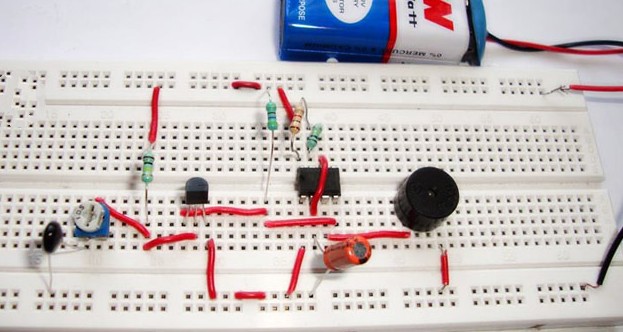Fire alarms are essential safety devices in homes and buildings, particularly critical in high-risk environments like banks, data centers, and gas stations. They act as early fire detection systems, sensing smoke or heat to trigger an alarm and warn occupants. This precious warning allows people to evacuate quickly and take necessary measures to contain the fire, potentially saving lives and preventing significant property damage.
This project outlines a basic fire alarm system built using a versatile integrated circuit (IC) called the 555 timer. This timer plays a key role in sensing temperature increases in the surrounding environment, indicating a potential fire. When a temperature rise is detected, the circuit triggers an alarm, typically a buzzer, to alert those nearby.
here’s the circuit diagram for the fire alarm system using a 555 Timer IC, NPN transistor (BC547), and a thermistor
+9V
|
R3 (4.7K)
|
+----+---------------------+
| |
R2 (100K) |
| |
+----+ |
| |
| Buzzer
| |
+----+-----------+
|
C (10uF)
|
+----+----------- OUT (Pin 3 of 555 Timer IC)
|
|
+------+------+
| |
| |
R1 (1K) |
| |
| |
+------+------+
|
|
Thermistor (10K)
|
|
| |
| |
GNDExplanation:
- The buzzer in the circuit is driven by an oscillating signal produced by a 555 Timer IC in astable mode..
- The transistor (BC547) remains in the ON state when there is no fire because the thermistor has a high resistance (10K ohms).
- The thermistor’s resistance drops in the event of a fire, which lowers the transistor’s base voltage below its turn-on value and turns the transistor off.
- The 555 Timer IC can function since its reset pin (Pin 4) is no longer grounded when the transistor is off.
- The 555 Timer IC’s astable setup produces an oscillating output at Pin 3, which activates the buzzer and sounds a warning.
- You can alter the alarm sound’s frequency by adjusting the values of capacitor C and/or R2.
- A 9V battery powers the circuit.
Adjustment:
Make sure the buzzer is activated by even a little change in resistance by adjusting the variable resistor (RV1). With the thermistor unplugged and RV1 grounded, make this modification by progressively lowering the resistance until the buzzer sounds. Reconnect the thermistor after that.
Note:
Building a fire alarm circuit also makes use of a Germanium diode (DR25) as a heat sensor. It only conducts at temperatures higher than 70 degrees Celsius when linked in reverse bias.
Also read : Unraveling the Mystery: Why Did My Fire Alarm Go Off at 3am?


